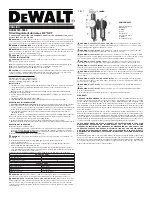
UK
18
Figure 3) back into the reservoir
tank.
The plant is ready for normal
operation.
If the plant has not quite
reached full capacity after the
cleaning, a new cleaning must
be made.
If, after this extra cleaning, the
capacity of the membrane is still
not satisfactory, it must be dis-
carded and a new installed.
12.2
Replacement of
plant membrane
Before cleaning, do as follows:
Switch off the power.
Disassemble the plastic hoses
located on the top of the mem-
brane (J-Figure 3).
Note: how the hose is connect-
ed, since it is important that the
hose be refitted in the same
way!
The hoses can be pulled out by
pushing the ring placed on the
stainless fitting; if pushed all the
way down, the hose can be
pulled out.
Dismount the U-lock located at
the end of the membrane pipe.
(The U-lock holds the membrane
endplate in place). Remove the
split pin from the U-lock and
pull the lock out of the pipe.
The end plate can now be
pulled out of the membrane
pipe by wriggling the end plate
from side to side and simultane-
ously pulling upwards.
Now pull the membrane out of
the membrane pipe. Note! at
which end the large black V-cup
seal is situated on the outside of
the membrane. When the new
membrane is fitted, this V-cup
seal must be fitted at the same
end of the membrane as the old
one, i.e. if the V-cup seal is at
the top of the membrane pipe,
the V-cup seal of the new mem-
brane must also be installed so
that the V-cup seal has to be
placed at the top when the
membrane is fitted inside the
membrane pipe.
When the membrane has been
replaced and the end plate has
been refitted with the U-lock in-
serted, remount all hoses.
Note! When the hose must be
pressed hard in to push-in fitting
until it clicks .
When all connections have been
refitted and end plates are se-
curely locked with the U-lock,
the plant must be restarted.
You may replace pre-filter (M-
Figure 3) by new 5”-5µ filter
cartridge.
Reconnect the raw water.
Open the outlet valve (B-Figure
3) completely.
Close the recirculation valve (D-
Figure 3) completely.
Dismount the permeate hose (A-
Figure 3) and lead it to drain.
Reconnect the power to the
plant.
The plant will now be operating.
Let it flush this way for 20-30
minutes.
Then adjust the outlet valve (B-
Figure 3) and the recirculation
valve (D-Figure 3), see section:
Start-up of plant.
Check the plant operating pres-
sure on manometer (E-Figure 3);
it should be 13.5-14.5 bar
which is normal operating pres-
sure.
Check that the water quality is
<20 µS/cm. This is checked on
the permeate hose (A-Figure 3)
(Conductivity meter is available
as aux. equipment). lead the
hose back when the quality is
satisfactory.
Check on flow meter (F-Figure
3) if the plant capacity is satis-
factory, maximum 160 l/h. The
plant is now in normal opera-
tion and ready for use.
Write in the operating journal:
1.
Date of replacement of
membranes
2.
New capacity of plant
(F-Figure 3)
3.
Water quality (µS/cm)
4.
Plant operating pres-
sure (E-Figure 3)
5.
Raw water pressure
6.
Raw water temperature
Summary of Contents for PERMAQ COMPACT 51
Page 2: ...UK 2...
Page 10: ...UK 10 9 2 3 Alarm Low raw water pressure 9 2 4 Alarm Transport pump...
Page 11: ...UK 11 9 2 5 Indication Level low 9 2 6 Alarm Level high...
Page 12: ...UK 12 9 2 7 The plant is not operating...
Page 20: ...UK 20 13 1 P I Diagram...
Page 21: ...UK 21 13 2 Layout Drawings...
Page 22: ...UK 22...
Page 23: ...UK 23...
Page 24: ...UK 24...
Page 25: ...UK 25 13 3 Wiring Diagrams...
Page 26: ...UK 26...
Page 27: ...UK 27...
Page 32: ...UK 32 13 7 Spare Parts Drawing...
















































